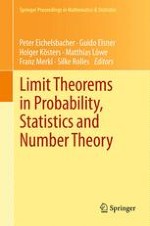2013 | OriginalPaper | Buchkapitel
Proportion of Gaps and Fluctuations of the Optimal Score in Random Sequence Comparison
verfasst von : Jüri Lember, Heinrich Matzinger, Felipe Torres
Erschienen in: Limit Theorems in Probability, Statistics and Number Theory
Verlag: Springer Berlin Heidelberg
Aktivieren Sie unsere intelligente Suche, um passende Fachinhalte oder Patente zu finden.
Wählen Sie Textabschnitte aus um mit Künstlicher Intelligenz passenden Patente zu finden. powered by
Markieren Sie Textabschnitte, um KI-gestützt weitere passende Inhalte zu finden. powered by
